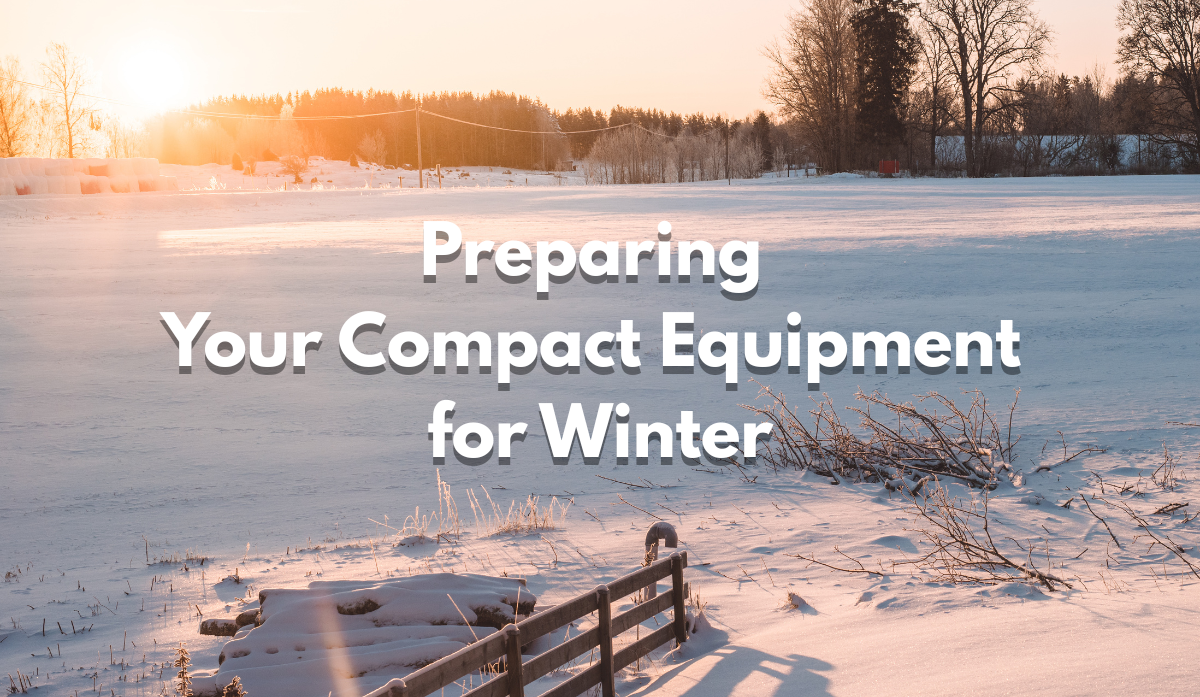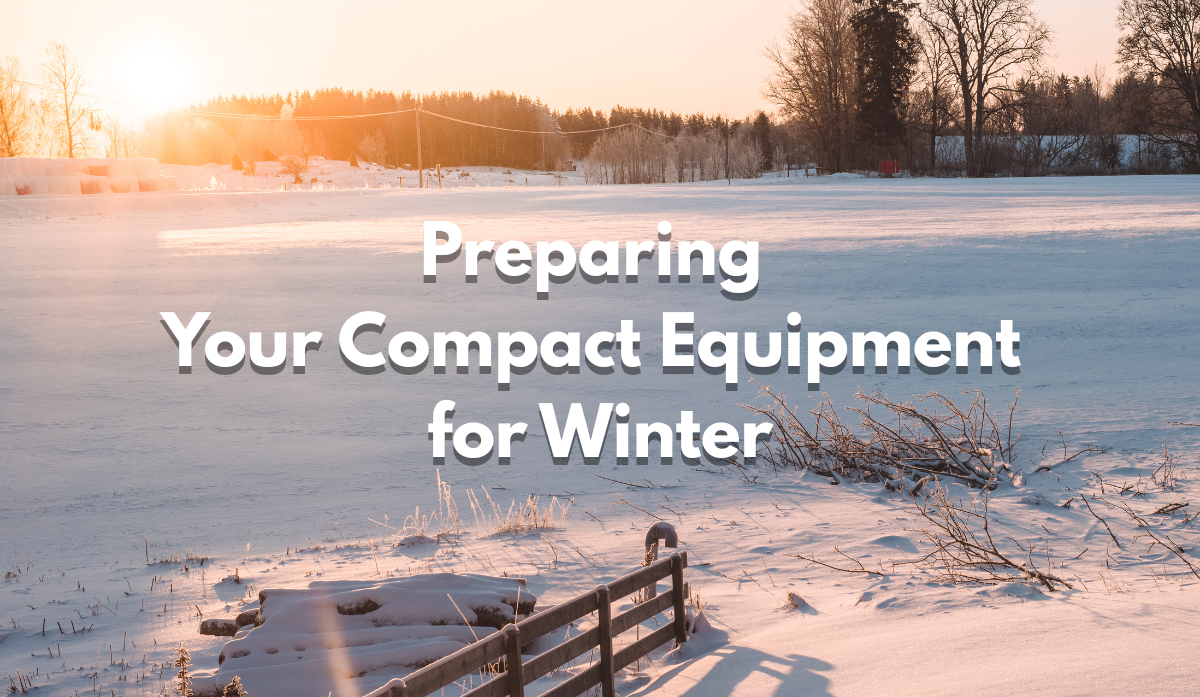Preparing Your Compact Equipment for Winter
Posted by Dr. Sara McCaslin on Nov 22nd 2025
The temps are dropping, but deadlines don’t stop. The last thing you need is sluggish hydraulics, dead batteries, and compact equipment that just refuses to move. Cold weather will expose any weak points in your skid steers, CTLs, and mini-excavators. But a little maintenance now can prevent that costly downtime later.

In this Shop Talk Blog post, we’re going to look at the steps you can take to minimize the chances of cold-weather breakdowns.
Check Your Hydraulic Fluid Before Temperatures Drop
Cold weather is going to thicken hydraulic fluid, slowing response times and putting a lot of stress on your final drives and hydraulic pumps. The best way to avoid this is to use the correct winter-grade, manufacturer-recommended fluid. And leads to something else: using old or contaminated hydraulic fluid in cold weather is going to make problems even worse.
These issues include permanent damage from cavitation, sluggish final-drive motors, and a weak lift response. This not only slows down the work you’re trying to do but can also lead to severe damage to your drive motors. And when the hydraulic fluid is too thick, you risk problems with dry starts and premature wear. Experts recommend warming the machine before using it.
Inspect and Protect Your Final Drives
Special attention to your final drive motors is also important because the cold weather can hit them hard. Three major problems are …
- Thickened oil
- Water contamination turning into ice crystals
- Seals becoming brittle
To minimize these issues, start by checking the gear oil levels and inspecting for milky or dark fluid. A milky fluid indicates water contamination, which can lead to the ice crystals mentioned. Dark fluid indicates it needs to be replaced and may contain contamination. Cold can cause already weakened seals to crack and leak, so keep an eye out for leaks. And keep in mind that if fluid can get out, contamination can get in. Finally, winter is a good time to replace the case drain filter to prevent obstructions.
Battery, Starter, and Electrical System Check
Cold temperatures slow chemical reactions inside batteries, and hard starting becomes common. Experts recommend testing the battery's load capacity and replacing any weak batteries as the weather gets colder. Also, take the time to clean the battery terminals to improve cold-start reliability, and look for worn wiring sleeves or cracks caused by cold.
Fuel System Prep (Diesel Machines)
For diesel equipment, keep in mind that diesel gels in the cold. That’s why it's a good idea to use an anti-gel treatment before the temperatures plunge and replace your fuel filters to prevent moisture-freeze-ups. Finally, you should drain water separators frequently since condensation increases in winter.
Inspect Hoses, Seals, and Rubber Components
Keep in mind that hydraulic hoses will stiffen and become brittle in cold temperatures, which increases the chances of cracks developing. And this is also true of rubber track components and idlers. You should periodically check your hoses for signs of abrasions, bulges, or cracks. And take the time to replace old hoses now, instead of waiting until temperatures drop to sub-zero. Finally, clean around seals and tracks to prevent ice buildup in areas where it can cause damage.
Undercarriage and Track Care
Frozen mud can quickly build up around the sprockets and rollers on your machine’s tracks, and as the rubber stiffens, it can change the track tension. This can lead to all kinds of problems, so here’s what the experts recommend that you do:
- Keep track tension slightly looser in winter, per manufacturer recommendations
- Leave your equipment idling long enough to warm the hydraulic oil before moving it
- Daily clean your tracks and undercarriage, especially after especially slushy or muddy jobs
Cold-Weather Grease and Lubrication Points
Hydraulic fluid and gear oil aren’t the only things that can thicken: grease can, too. Because of this, it might be a good idea to switch to a cold-rated grease designed for low-temperature flow and take the time to lubricate key pivot points to keep arms and attachments moving freely.
Storage Tips to Protect Your Equipment
If it’s possible, you should store your compact equipment under a cover or inside a shop. This reduces cold soak and can make a big difference in equipment performance during the cold winter months. You can also use block heaters, hydraulic tank heaters, or battery maintainers for frequently used machines. The equipment does have to be stored outdoors, cover the control panel and seat, and make sure to keep snow and ice from building up on the tracks and sprockets. And don’t forget to protect exposed lines and connectors from ice buildup
Attachment-Specific Winter Checks
Don’t forget your attachments! Your buckets, augers, trenchers, snow attachments, and breakers all need winter prep. This includes checking the hoses and cylinders to cracks, looking at the quick-attach plates to ensure there’s no debris that could freeze, and using cold-compatible grease on moving joints.
Warm-Up Procedure: Don’t Skip It
When the temperatures are cold, let your compact equipment warm up for several minutes before running it. This kind of warm-up lets the hydraulic fluid and gear oil reach a more workable viscosity and gives seals a chance to soften and seat properly.
Here’s a handy checklist:
- Clear snow and ice from tracks, steps, attachment points, and around the final drives
- Check all fluid levels, especially hydraulic oil and gear oil in the final drives
- Inspect for leaks that may have appeared overnight from shrinking seals
- Verify battery health: clean terminals, ensure a strong crank
- Cycle the glow plugs (on diesel machines) before starting
- Idle the engine for 5–10 minutes to let the hydraulic fluid warm and thin out
- Slowly cycle controls (i.e., lift, tilt, travel direction) to warm cylinders and spool valves gradually.
- Check track tension
- Let the machine move slowly at first, avoiding heavy loads until full operating temperature is reached
Final Drive Tip: Winter Is When Small Problems Become Big Ones
When it comes to your final drives, there’s a few things to keep in mind. Cold weather is going to amplify any pre-existing issues, and here’s what that could look like:
- Slow travel response = thick oil or case drain restriction
- Loss of power = weak hydraulic fluid flow or failing motor
- Leaks that were “minor” in summer become major when seals shrink in the cold
Conclusion
Winter preparations is always going to be cheaper then having to make mid-season repairs and deal with unplanned downtime. And you’ve got a well-maintained machine, it’s going to run smoother, start easier, and last longer during the icy cold winter months.
If your final drive is running sluggishly in the cold or you’re not sure whether it’s winter-ready, give us a call. Final Drive Parts can help you troubleshoot issues and find the right parts before the damage worsens.







